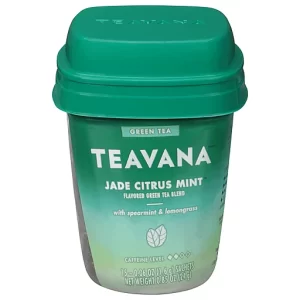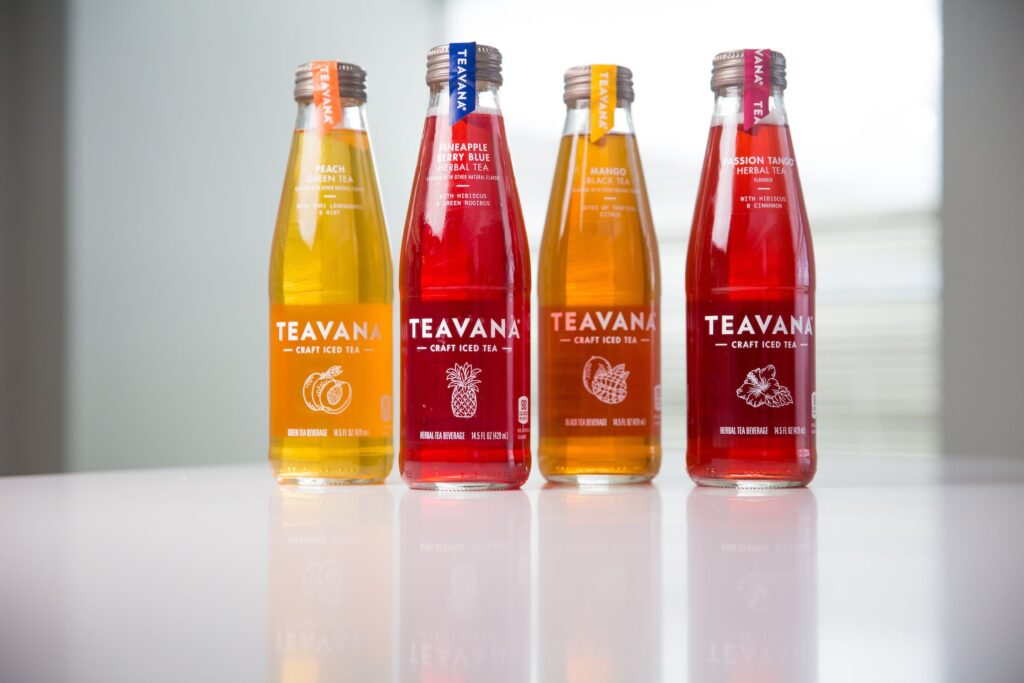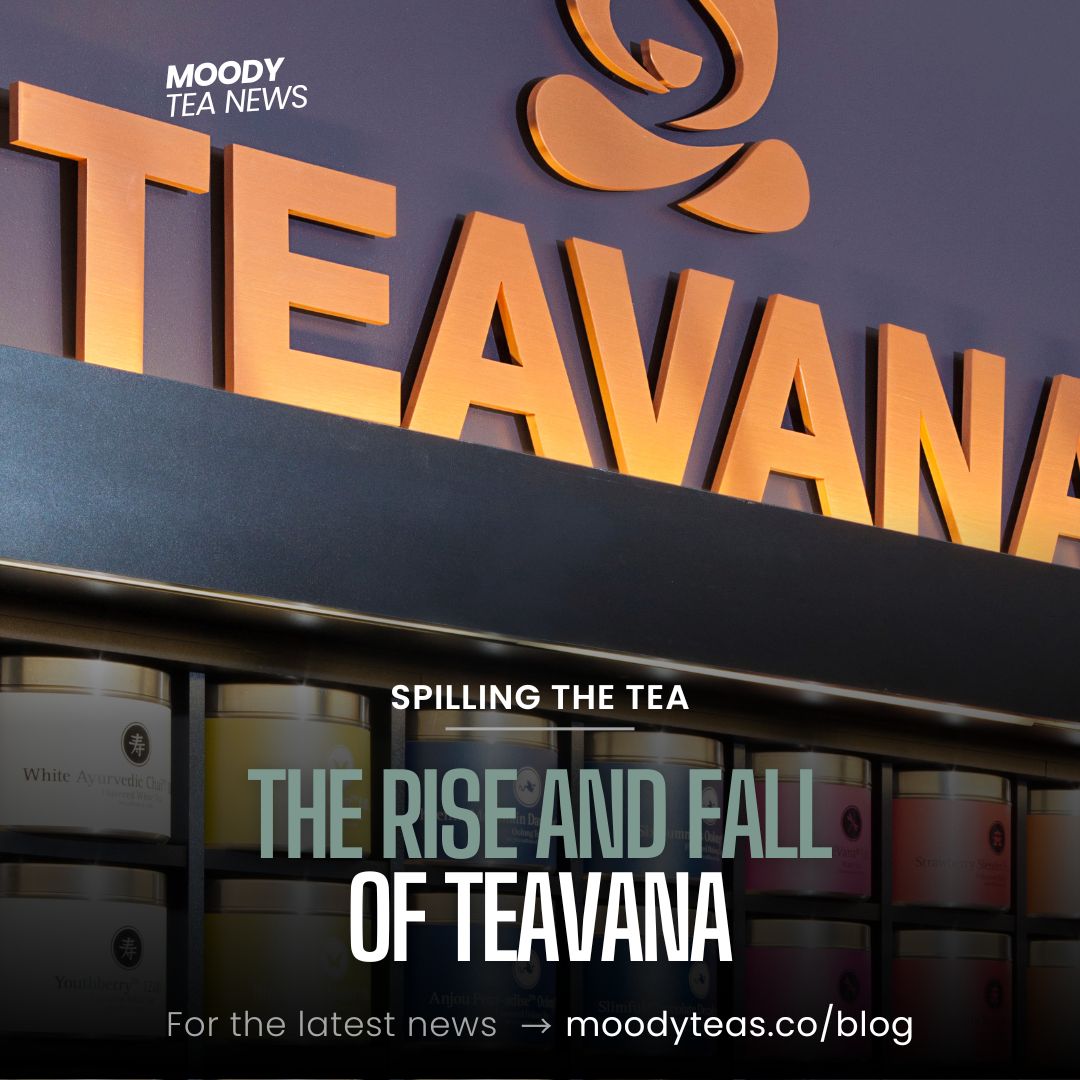Tea isn’t just a beverage—it’s a ritual, a comfort, and for some of us, a life-changing passion. That’s why we’re kicking off today’s edition of “Spilling the Tea” by taking a look at one of the most iconic players in the American tea scene: Teavana. From their meteoric rise as a mall-based tea empire to their rapid decline, Teavana’s story is a fascinating brew of ambition, missteps, and lessons learned.
And for us, this story hits close to home. Why? Because our very own co-founder, John, spent time working in a Teavana store in Cleveland, Ohio. It was there, amidst the gleaming tins of loose-leaf blends and pushy sales pitches, that their love for tea truly blossomed. But more on that later—first, let’s steep ourselves in the story of Teavana’s rise and fall.
A Heavenly Beginning: Teavana’s Early Days
Back in 1997, Andrew and Nancy Mack had a vision. Inspired by the rich tea cultures they encountered on their travels, they opened the first Teavana store in Atlanta, Georgia. The name itself—a combination of “tea” and “nirvana”—promised an elevated, almost spiritual tea experience. Their mission was to bring the world of loose-leaf teas and artisanal brewing techniques to American consumers, many of whom were stuck in a tea bag rut.
Teavana wasn’t your average tea shop. Walking into one of their stores felt like stepping into an exotic tea bazaar. Glass jars of loose-leaf teas lined the walls, each with enticing names like “Samurai Chai Mate” and “Youthberry.” Customers were encouraged to smell the blends, taste free samples, and get schooled on brewing methods by in-store “teaologists.” It was a full-on sensory experience, and it worked.
By the early 2000s, Teavana was expanding rapidly. Their unique approach to retail tea, coupled with a growing interest in health-conscious lifestyles, made them a hit. In 2011, the company went public, raising $121 million to fund even more growth. Teavana seemed unstoppable.
John’s Story: Teavana, Cleveland, and the Spark of Passion
For John, Teavana wasn’t just a place to work—it was a crash course in the art and science of tea. During their time as a sales associate in Cleveland, they learned how to brew the perfect cup, explain flavor profiles, and wax poetic about oolong oxidation levels. It was an environment that celebrated tea’s complexities, and John soaked it all in.
But it wasn’t all roses (or rosehip infusions). As John recalls, “There was this intense focus on upselling. The training was less about fostering a love for tea and more about getting customers to leave with three tins of tea they didn’t need and a $60 cast iron teapot. It felt…off.”
That pressure to upsell was a hallmark of Teavana’s sales strategy—and one of its biggest flaws. “It was hard to build genuine connections with customers,” John says. “It was all about the transaction, not the tea.”
Still, the experience ignited John’s passion. They left Teavana with a deeper appreciation for the craft of tea—and a clear sense of what they wanted to do differently if they ever started their own tea brand.
The Starbucks Era: Big Dreams, Bigger Challenges
In 2012, Teavana hit the big leagues when Starbucks acquired the brand for $620 million. The coffee giant saw enormous potential in Teavana as a way to expand into the $90 billion global tea market.
Starbucks had big plans. They envisioned transforming Teavana stores into “shrines to tea,” creating a premium, immersive experience similar to their coffeehouses. They also planned to integrate Teavana products into Starbucks stores, making high-quality tea accessible to millions of coffee drinkers.
On paper, it was a smart move. In practice? Not so much.
Tazo vs. Teavana: Starbucks’ Two-Tea Tango
Now, some of you might be thinking, “Wait a second… didn’t Starbucks already have Tazo teas?” And you’d be right! Long before Starbucks bought Teavana, they were already cozy with another tea brand—Tazo. Back in 1999, Starbucks snagged Tazo for a cool $8.1 million. Known for its playful, quirky branding and bold blends, Tazo was primarily sold in grocery stores and Starbucks cafés. It was the kind of tea you’d grab on your weekly supermarket run or grab from Starbucks when you’d already had enough coffee for the day.
Then came Teavana in 2012. If Tazo was the everyday tea friend, Teavana was meant to be the sophisticated cousin. Teavana’s whole vibe was premium, immersive, and a little bougie. The plan was to let the two brands do their own thing—Tazo for the mass market, Teavana for the tea connoisseurs. Sounds good, right?
Well, not so much. The problem was, customers didn’t always know the difference between the two brands, and frankly, neither did Starbucks. Should they put their energy into Tazo’s grocery store dominance or double down on making Teavana a lifestyle experience? Trying to juggle both tea brands at once led to some serious brand confusion. Perhaps the most notable example here is the great Passion debacle—when Starbucks swapped out Tazo’s beloved Passion Iced Tea for Teavana’s Passion Tango, leaving customers scratching their heads. Was it the same tea? A new tea? Why the rebrand? It was a classic case of brand confusion that left a sour taste in what should have been a sweet moment.
By 2017, Starbucks decided enough was enough. They sold Tazo to Unilever for $384 million, officially making Teavana their one and only tea focus. The idea was to give Teavana all the attention it needed to thrive. But by then, Teavana’s retail stores were already struggling, and it was clear that the brand had bigger problems than sibling rivalry with Tazo.
Steep Challenges: Where Teavana Lost Its Way
While Teavana’s vision of elevating tea culture was admirable, several aspects of their business model didn’t hold up over time. And for us at Moody Teas, these missteps highlight exactly what not to do when building a tea brand.
1. Reliance on Mall-Based Stores
Teavana’s growth was tied to shopping malls—locations that, even in the early 2010s, were starting to see declining foot traffic. As e-commerce boomed and consumers shifted their shopping habits, Teavana’s reliance on physical mall stores became a liability.
At Moody Teas, we’ve embraced a hybrid model that’s grounded in community engagement through farmers’ markets and pop-ups, with the option to order online always available. It’s a flexible, sustainable approach that meets our customers where they are—whether they’re browsing a weekend market or searching for their next favorite blend from the comfort of home. Teavana, on the other hand, seemed stuck in an outdated retail strategy, tethered to mall-based stores that couldn’t keep up with the evolving preferences of tea drinkers.
2. Premium Pricing
Let’s talk about those price tags. Teavana positioned itself as a luxury brand, with prices to match. While the quality of their tea was generally good, it wasn’t always that good. Customers often walked away feeling like they’d overpaid—especially after being upsold on accessories they didn’t really need.
At Moody Teas, we believe that great tea shouldn’t break the bank. Sure, we offer premium blends, but we’re also committed to transparency and value. We’d rather you come back for more because you love the tea, not because you feel pressured into a big purchase.
3. Focus on Sales Over Community
Teavana stores were beautiful, but they weren’t always welcoming. The sales-first mentality created a transactional vibe that didn’t foster genuine connections. Compare that to a cozy tea shop where you can sip, chat, and linger—it’s a world of difference.
From day one, Moody Teas has been about building community. Whether it’s through our blog, our social media, or our collaborations with local businesses, we’re here to share our love of tea—not just sell it.
The Bitter End: Teavana’s Closure
By 2017, the cracks in Teavana’s business model were impossible to ignore. Starbucks announced plans to close all 379 Teavana stores, citing underperformance and the challenges of mall-based retail. While Teavana-branded products would still be available in Starbucks locations, the standalone stores were done.
For many tea lovers, it was a bittersweet moment. On one hand, Teavana had introduced countless people to the world of loose-leaf tea. On the other hand, the brand had strayed so far from its original vision that its closure felt almost inevitable.
What Became of Teavana After the Stores Closed?

When Starbucks announced the closure of all 379 Teavana stores in 2017, many tea lovers assumed it was the end of the brand entirely. But Teavana wasn’t completely steeped out of existence. Instead, it transitioned into a new chapter—one that’s much quieter but still present in the tea world.
Teavana in Starbucks Stores
Starbucks retained the Teavana name as part of its product lineup, integrating it into its coffeehouses and ready-to-drink offerings. If you’ve ever ordered a chai latte or a peach green tea lemonade at Starbucks, chances are you’ve sipped on a Teavana blend.
While the standalone stores are gone, you can still find loose-leaf teas under the brand in Starbucks locations and select grocery stores. However, the range is far more limited compared to the expansive offerings of the old Teavana stores. Many of the unique blends and rare teas that once lined Teavana’s shelves have disappeared, replaced by crowd-pleasing staples that appeal to a broader audience.
Teavana Bottled Beverages

One of the more visible remnants of Teavana is its line of ready-to-drink bottled teas. Starbucks partnered with beverage giant Anheuser-Busch to produce and distribute these teas, which are available in grocery stores and convenience outlets. The bottled teas are marketed as premium, flavorful options for on-the-go tea drinkers. While they’ve garnered some success, they lack the immersive, educational experience that once defined the Teavana brand.
The Legacy of Teavana Online
Teavana’s online presence remains minimal. While Starbucks occasionally features Teavana-branded teas on its website, the brand no longer operates its own e-commerce site. This is a stark contrast to the original vision of Teavana, which aimed to create a dedicated community of tea enthusiasts.
What’s Missing?
The biggest loss from Teavana’s transformation is the immersive, hands-on experience that made their stores so unique. For all its faults, Teavana introduced many people to the world of loose-leaf tea for the first time. The vibrant blends, in-store tastings, and passionate (albeit sales-driven) teaologists created a sense of excitement that’s hard to replicate through prepackaged products or grocery store aisles.
How Moody Teas Compares
Teavana’s shift away from community-driven experiences and specialty teas highlights what sets Moody Teas apart. While Teavana now operates as a shadow of its former self, Moody Teas thrives on connection, education, and variety. Whether it’s through a farmers’ market pop-up or an online chat about the perfect steeping time for oolong, we’re here to keep the spirit of tea culture alive and well.
In the end, Teavana’s story reminds us that tea isn’t just about the product—it’s about the experience, the community, and the love that goes into every cup. While Teavana’s storefronts are gone, the lessons they left behind continue to shape the future of tea culture—and brands like Moody Teas are here to carry that torch forward.
Teavana’s Legacy—and What We’ve Learned
So, what’s the takeaway from Teavana’s rise and fall? For us at Moody Teas, it’s a mix of admiration and caution.
Teavana did a lot right. They made loose-leaf tea mainstream, brought global tea traditions to American audiences, and proved that tea could be more than just a dusty box on a grocery store shelf. But their missteps—overpricing, outdated retail strategies, and a focus on sales over substance—serve as important lessons for anyone in the tea industry.
For John, those lessons are deeply personal. “Working at Teavana showed me both the beauty of tea and the pitfalls of a corporate approach to something so intimate,” they say. “With Moody Teas, I wanted to take the good—the education, the passion, the creativity—and leave the rest behind.”
A Toast to the Future
At Moody Teas, we’re proud to be part of the new wave of tea culture—one that prioritizes authenticity, accessibility, and community. We’re here to celebrate tea in all forms, from simple chamomiles to bold, spicy chai. And as we continue to grow, we’ll carry the lessons of Teavana with us, steeping them into every blend we create.
So here’s to Teavana: the good, the bad, and the fragrant. Thanks for paving the way—and for teaching us what not to do. Now, who’s ready for another cup?



Leave a Reply